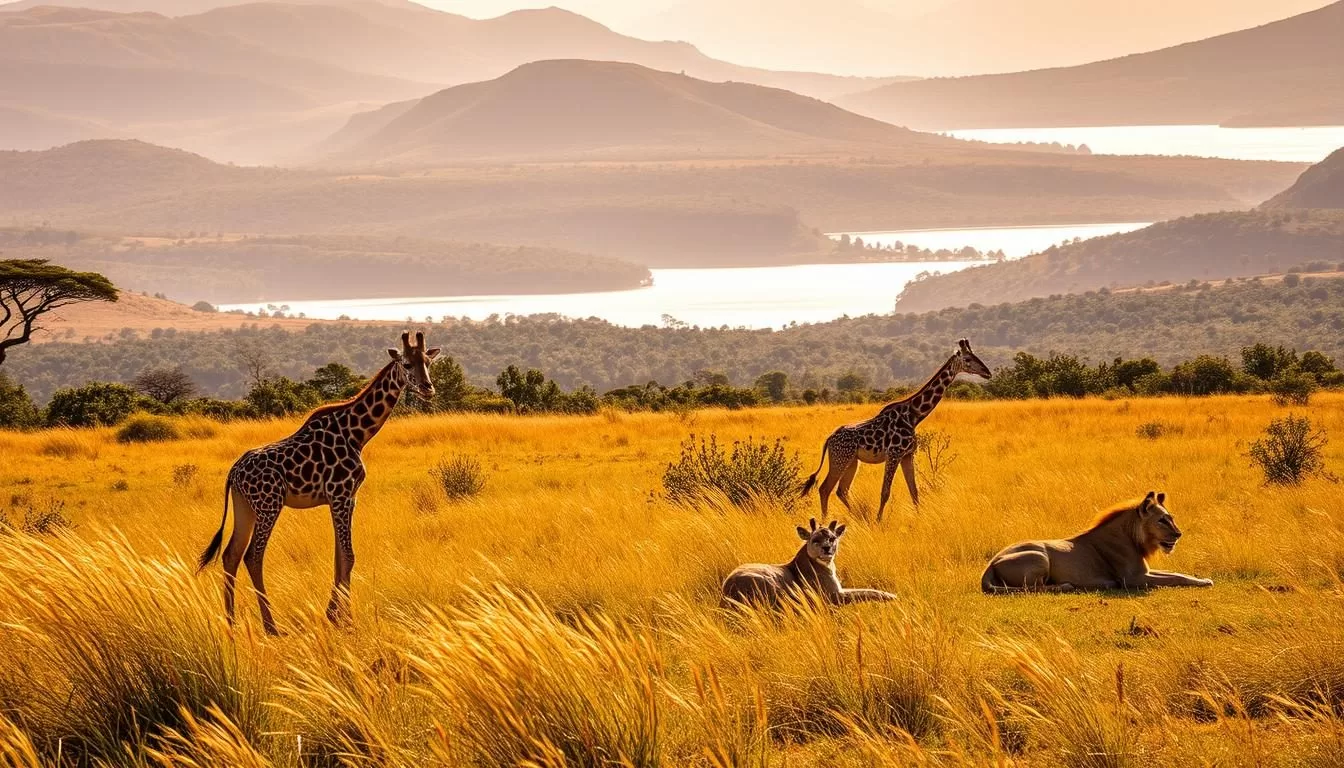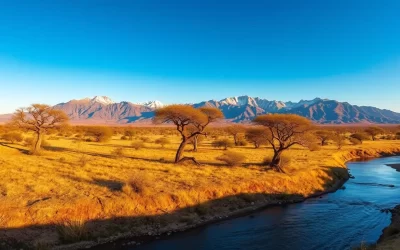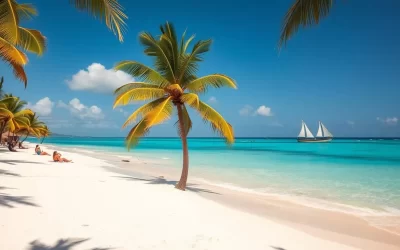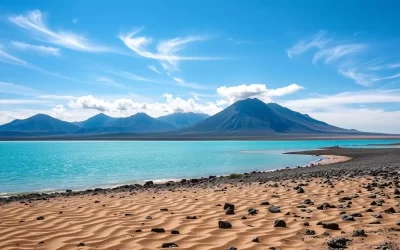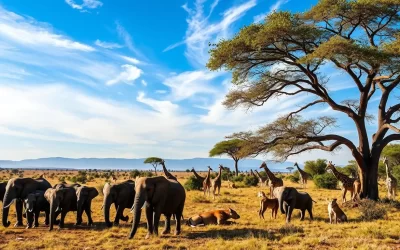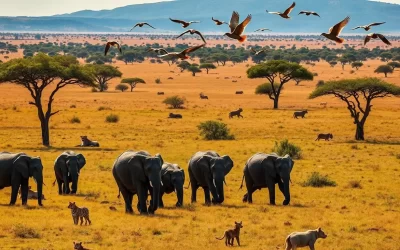✓ Accommodations ✓ Flights ✓ Rental Cars
You’re just a three-hour drive from Nairobi to one of Kenya’s premier wildlife destinations. Lake Nakuru National Park boasts an abundance of wildlife and spectacular landscapes, featuring black and white rhinos, lions, leopards, and hippos.
The park’s unique ecosystem centers around a shallow alkaline lake that has historically attracted millions of flamingos. As a renowned conservation area since 1957, it was declared a national park in 1968. You’ll experience thrilling safari adventures and peaceful bird watching opportunities amidst scenic viewpoints.
Discover why this park is a must-visit for any adventure seeker. With its rich biodiversity and stunning landscapes, you’ll be treated to an unforgettable experience.
Discovering Lake Nakuru National Park
Located in Kenya’s Great Rift Valley, Lake Nakuru National Park is a haven for nature lovers and wildlife enthusiasts alike. As you explore this unique ecosystem, you’ll discover the fascinating aspects that make it a must-visit destination.
Location and Geography
Lake Nakuru is situated in the Great Rift Valley, a geographical feature known for its volcanic activity and diverse landscapes. The park’s terrain is varied, with the lake being a central feature surrounded by grasslands, woodlands, and rocky outcrops.
Brief History and Conservation Status
The park has a rich history, having been established to protect the black and white rhinos. Conservation efforts have been ongoing to ensure the safety and proliferation of these and other species within the park. Lake Nakuru was designated a national park in 1961 and is now a UNESCO World Heritage Site.
| Year | Event | Conservation Impact |
|---|---|---|
| 1961 | Lake Nakuru designated as a national park | Enhanced protection for wildlife |
| 2014 | Rising water levels affect flamingo population | Changes in breeding and feeding grounds |
The Famous Alkaline Lake
 alkaline lake is a unique feature of Lake Nakuru, with waters rich in sodium carbonate that support specialized algae. These algae are a crucial food source for the flamingos, which once numbered over 1.5 million. Although the population has fluctuated due to changes in water levels, the lake remains an essential habitat.
alkaline lake is a unique feature of Lake Nakuru, with waters rich in sodium carbonate that support specialized algae. These algae are a crucial food source for the flamingos, which once numbered over 1.5 million. Although the population has fluctuated due to changes in water levels, the lake remains an essential habitat.
The lake’s chemistry, influenced by volcanic activity, creates a unique ecosystem. Historically, this supported a vast flamingo population, turning the lake into a pink spectacle. While recent changes have affected this phenomenon, Lake Nakuru remains a significant ecological site.
Wildlife Safari: The Ultimate Experience
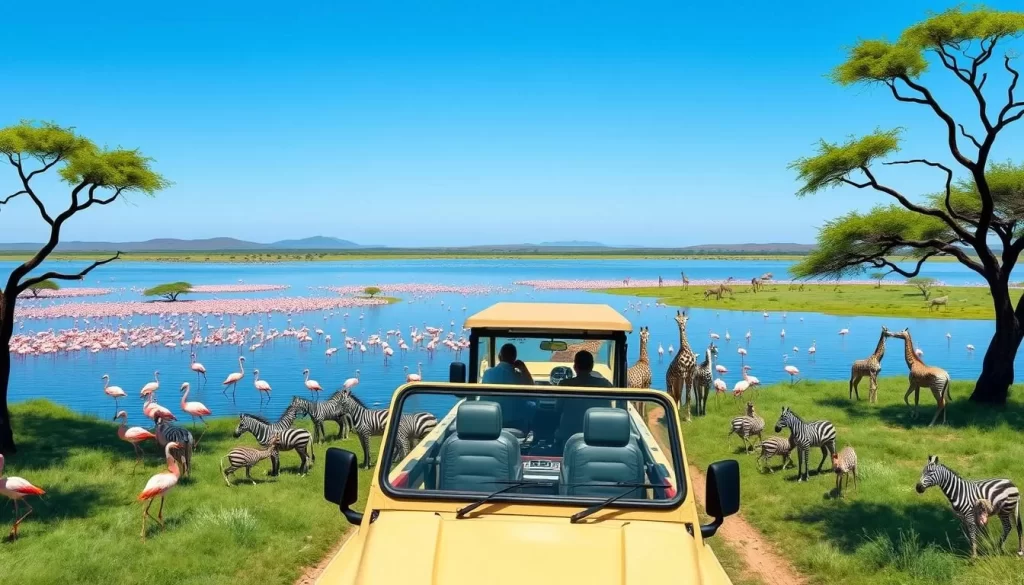
The wildlife safari at Lake Nakuru National Park is an ultimate experience, with over 50 mammal species to spot. As you explore the park, you’ll be surrounded by an abundance of wildlife, making every moment a thrilling encounter.
Rhino Sanctuary: Black and White Rhinos
Lake Nakuru National Park is renowned for its Rhino Sanctuary, home to both black and white rhinos. Conservation efforts have successfully protected these magnificent creatures, allowing visitors to witness them up close in their natural habitat. The sanctuary is a testament to the park’s commitment to preserving endangered species.
Big Cats: Lions and Leopards
The park is also a haven for big cats, including lions and leopards. With patience and a keen eye, you might catch a glimpse of these majestic predators as they roam their territory. The diverse habitats within the park support a healthy population of these magnificent animals, making it a prime location for viewing them.
Other Mammals: Giraffes, Zebras, and Buffalos
Beyond the rhinos and big cats, Lake Nakuru National Park is home to a variety of other mammals. You’ll encounter zebras, giraffes, and buffalos, among others, as you explore the park’s diverse landscapes. The abundance of wildlife creates a dynamic ecosystem, with many fascinating interactions to observe.
As you enjoy your safari, you’ll appreciate the ecological roles these animals play in maintaining the park’s ecosystem. From the grazing patterns of zebras to the social structures of giraffes, every observation offers a deeper understanding of the natural world.
Bird Watching Paradise
As an internationally recognized Important Bird Area, Lake Nakuru National Park is a must-visit destination for anyone passionate about birds. The park’s diverse habitats support an incredible array of species, making it a premier location for bird watching.

The Flamingo Population: A Story of Resilience
The flamingo population at Lake Nakuru has been a subject of interest for many years. While their numbers have fluctuated due to various environmental factors, the lake remains a crucial habitat for these iconic birds. The alkaline lake provides a unique environment that supports the flamingos’ feeding habits.
| Year | Flamingo Population |
|---|---|
| 2000 | 1,000,000 |
| 2010 | 500,000 |
| 2020 | 750,000 |
Diverse Bird Species Beyond Flamingos
Beyond the famous flamingos, Lake Nakuru National Park is home to an estimated 450 bird species. You can spot impressive water birds including pelicans, cormorants, herons, and storks that gather along the lake’s shores and in surrounding wetlands. The park’s diverse habitats also support magnificent raptors like the African fish eagle and the majestic Verreaux’s eagle.
Some of the other bird species to look out for include ostriches, African fish eagles, woolly-necked storks, and dusky nightjars, plus an array of other bird species. Professional guides can help you identify specialized woodland birds in the acacia forests, including barbets, woodpeckers, and the beautiful superb starling.
Lake Nakuru National Park: Best Things to Do – Top Picks
Discover the top picks for things to do at Lake Nakuru National Park, where wildlife and landscapes converge. The park offers a diverse array of experiences that cater to different interests, ensuring that your visit is both memorable and enriching.
Game Drives: Morning and Afternoon Adventures
Embark on a safari adventure with game drives that take you through the heart of Lake Nakuru National Park. Morning and afternoon game drives offer unique experiences due to the different behaviors of the wildlife during these times. You’ll have the chance to witness the majestic wildlife in their natural habitat, from the majestic lions to the elusive leopards.
The park’s well-maintained tracks and knowledgeable guides ensure that you get up close to the animals while maintaining a safe distance. The morning drives often catch the animals during their most active hours, while the afternoon drives offer a relaxed atmosphere with the golden light of the setting sun.
Hiking and Nature Walks
For those who prefer a more leisurely pace, Lake Nakuru National Park offers hiking and nature walks that allow you to immerse yourself in the natural beauty of the landscapes. The park has several trails that cater to different fitness levels, ranging from easy strolls to more challenging hikes.
One of the highlights is the hike to the lake‘s viewpoints, such as Baboon Cliff, which offers breathtaking views of the lake and the surrounding landscape. These walks not only provide an opportunity to enjoy the scenery but also to observe the park’s diverse flora and fauna up close.
Photography Opportunities
The richness of wildlife at Lake Nakuru lends itself to incredible photographic opportunities, from captivating landscapes to emotive wildlife portraits. The park is a haven for photographers, with its diverse landscapes, including the expansive lake views and dramatic acacia trees silhouetted against colorful African sunrises and sunsets.
- The park’s elevated viewpoints provide perfect vantage points for capturing sweeping panoramas.
- You’ll capture the park’s reliable sightings of endangered species like rhinos and Rothschild’s giraffes.
- The varied birdlife presents unique photography challenges and rewards, from capturing the pink mass of flamingos to freezing the moment a fish eagle dives for prey.
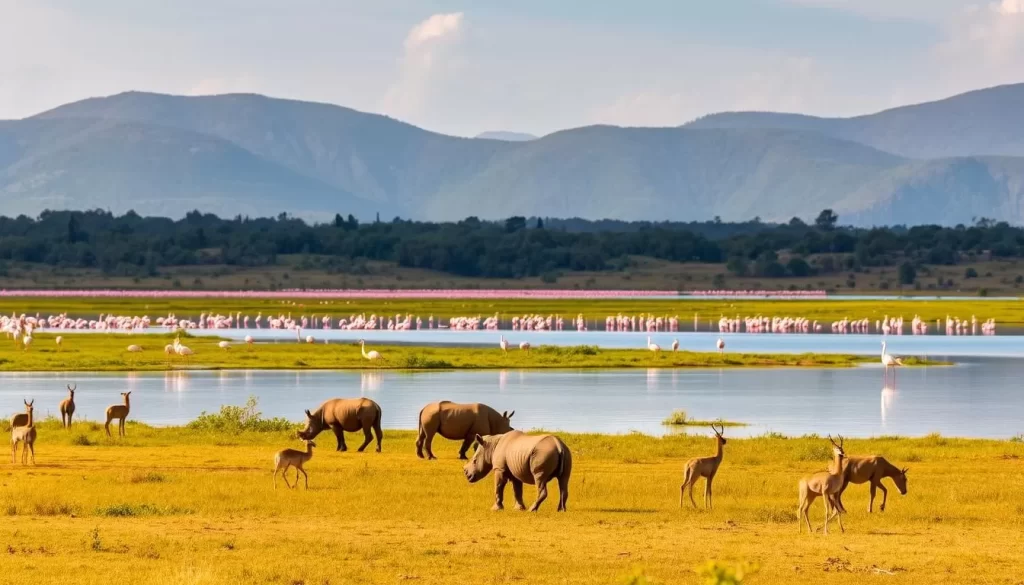
Scenic Viewpoints and Natural Attractions
As you explore Lake Nakuru, you’ll discover an array of stunning viewpoints and natural wonders that showcase the park’s diverse landscapes. The park is home to several scenic viewpoints and natural attractions that are a must-visit for any traveler.
Baboon Cliff Lookout Point
The Baboon Cliff Lookout Point offers a panoramic view of the lake and surrounding landscape. It’s an ideal spot for observing the park’s wildlife and taking in the breathtaking scenery. You can enjoy the serene atmosphere and capture memorable moments through your camera lens.
Makalia Falls
Makalia Falls is another natural attraction within the park, providing a picturesque setting amidst the African wilderness. The falls are a great spot for a picnic or a short walk, allowing you to connect with nature. The surrounding area is teeming with life, making it a perfect location for nature enthusiasts.
Out of Africa Outlook
The Out of Africa Outlook, situated on the southwestern shores of lake Nakuru, is a must-visit viewpoint. It offers sweeping views that capture the essence of the Kenyan wilderness, creating a quintessential African landscape. You can enjoy a leisurely picnic between 10 am and 5 pm when the weather is typically calm and pleasant, making for a memorable dining experience.
- Experience the magic of the Out of Africa Outlook, with its expansive vistas of the lake and surrounding plains.
- Use binoculars to scan the terrain and potentially spot large herds of buffalo and rhinos moving across the savannah.
- Capture stunning sunset views as the sky transforms through an array of colors reflected in the lake waters.
- Enjoy a peaceful time at this elevated location, perfect for both photography and quiet contemplation.
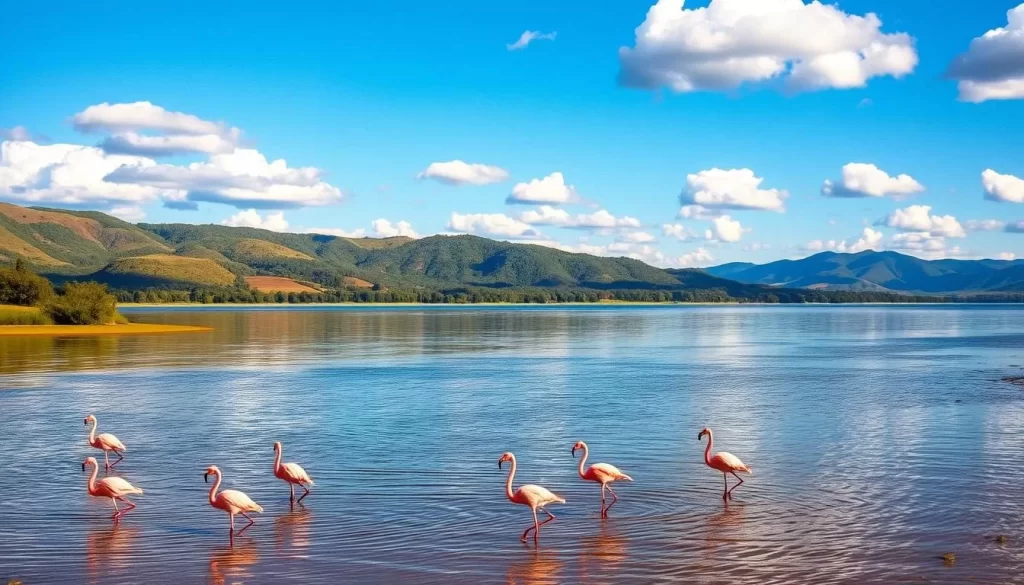
| Attraction | Description | Best Time to Visit |
|---|---|---|
| Baboon Cliff | Panoramic view of the lake and surroundings | Morning or Afternoon |
| Makalia Falls | Picturesque setting for picnics or walks | Anytime |
| Out of Africa Outlook | Sweeping views of the Kenyan wilderness | 10 am – 5 pm |
Where to Stay: Accommodation Options
As you plan your trip to Lake Nakuru, you’ll find that the park and its surroundings offer a diverse range of places to stay. You can choose from an array of options, part of which are located inside the park for an immersive experience, while others are in Nakuru town, offering a more budget-friendly alternative.

Lodges Inside the Park
For those who want to be close to the action, lodges inside Lake Nakuru National Park provide an abundance of opportunities to engage with wildlife. These lodges offer comfortable accommodations and often have guided tours and game drives as part of their packages. You’ll be able to take a drive through the park at dawn or dusk when the animals are most active.
Some of the notable lodges inside the park include Lake Nakuru Lodge and Savor Lion Hill Game Lodge. These lodges offer luxurious amenities and stunning views of the surrounding landscape.
Tented Camps and Safari Experiences
Tented camps offer a more immersive safari experience, with many camps located in prime wildlife viewing areas. These camps often provide guided safaris and other activities, such as nature walks and bird watching. You’ll be able to experience the sights and sounds of the African savannah in an intimate setting.
Kambi Amani and similar tented camps provide a unique experience, with comfortable tents and shared facilities. They are ideal for those who want to be part of the safari experience without sacrificing comfort.
Budget-Friendly Options in Nakuru Town
If you’re on a tighter budget, Nakuru town offers an abundance of budget-friendly accommodation options. You’ll find a range of hotels and guesthouses, such as Empalos Hotel, Sandal Wood Suites, and North Manor, which offer comfortable rooms at a fraction of the cost of in-park lodges. While you’ll need to take a short drive to the park each day, the savings can be significant.
The Sarova Woodlands Hotel and Spa is another excellent option, with spacious rooms, multiple dining options, and an outdoor pool. It provides an array of amenities and services, making it a great choice for those who want to balance comfort and affordability.
Planning Your Visit to Lake Nakuru
Lake Nakuru National Park is a gem in the Great Rift Valley, and with some planning, you can have a truly exceptional wildlife safari experience. The park is renowned for its diverse wildlife, including the Black and White Rhinos in its sanctuary, as well as lions and leopards. To make the most of your visit, plan your trip during the dry seasons, either between January and March or July and October, when wildlife viewing is optimal.
The park’s accessibility is one of its advantages, being just a three-hour drive from Nairobi along well-maintained roads. For those preferring to fly, the Naishi airstrip accepts scheduled flights from Nairobi, reducing travel time to just 30 minutes. Entry fees for international visitors are $60 for adults and $35 for children per 24-hour period. It’s advisable to plan a full-day or multi-day visit to maximize value.
When visiting Lake Nakuru, consider incorporating it into a larger Kenya safari itinerary. The park pairs well with nearby destinations like Lake Naivasha, the Aberdare National Park, or the Masai Mara National Reserve for a comprehensive wildlife experience. Don’t forget to pack lightweight clothing, sun protection, and a good camera with a zoom lens to capture the diverse wildlife and spectacular landscapes. Booking your accommodation in advance is also recommended, especially during peak tourist seasons.
The above is subject to change.
Check back often to TRAVEL.COM for the latest travel tips and deals.
